Table of Contents
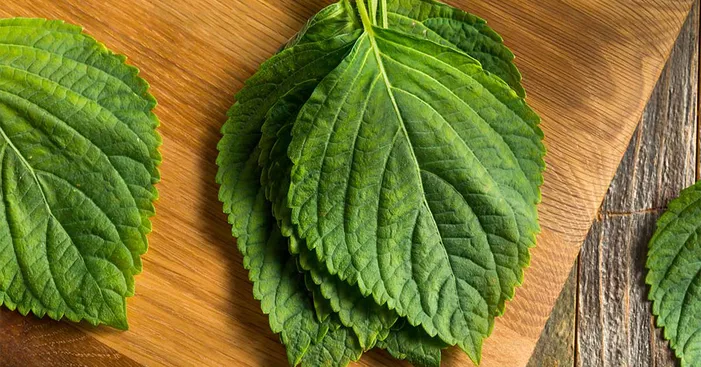
Shiso plant, a humble herb often overshadowed by its more flamboyant counterparts in the world of culinary delights, nevertheless harbors a wealth of health-promoting properties and a flavor profile that dances on the palate.
This unsung hero is none other than Shiso, a culinary chameleon with a rich history and a remarkable ability to transform any dish into a symphony of flavors and wellness.
Prepare to embark on a culinary adventure with shiso, where flavor and wellness intertwine seamlessly.
Discover its versatility as it adds a refreshing zest to salads, and transforms into flavorful pesto or graces sushi rolls with its vibrant green hues.
Let shiso tantalize your taste buds while quietly nurturing your well-being, proving that sometimes, the most unassuming ingredients hold the key to unlocking a world of culinary and health-enhancing possibilities.
General facts about shisho plant:

Shiso overview:
Emerging from the verdant tapestry of nature, shiso, a culinary and medicinal gem, unfolds a captivating tale of fragrance, flavor, and healing.
Its wrinkled, curled leaves, imbued with a symphony of earthy, minty, and slightly citrusy notes, have captivated the palates of discerning gourmands for centuries.
This unassuming herb, native to China, has traversed the vast expanse of Eurasia, gracing the kitchens of India, Myanmar, Japan, Korea, and Indonesia with its unique culinary and medicinal attributes.
In the realm of gastronomy, shiso reigns supreme as an aromatic chameleon.
Its leaves, known as Su leaves, dance across the palate, adding a subtle yet captivating zest to salads, garnishes, and stir-fries.
Their distinctive aroma, reminiscent of a blend of peppermint and citrus, harmonizes seamlessly with a myriad of flavors, transforming ordinary dishes into culinary masterpieces.
But shiso’s culinary magic extends beyond its leaves; its stems and seeds also contribute their unique essences, adding depth and complexity to soups, stews, and pickles.
Beyond its culinary prowess, shiso possesses a wealth of medicinal properties, deeply rooted in traditional Chinese medicine.
Its leaves, known as Su leaves, are revered for their anti-inflammatory and antispasmodic effects, making them invaluable remedies for respiratory ailments, digestive issues, and skin conditions.
The stems, known as Su stems, are thought to possess diuretic properties, while the seeds, known as Su seeds, are believed to promote heart health and regulate blood pressure.
Varieties of shiso leaves:
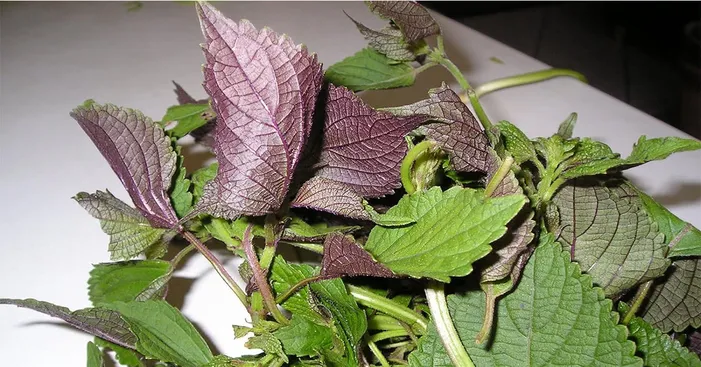
Shiso comes in two main varieties: red shiso, also known as akashiiso or chirimenjiso, and green shiso, also known as aojiso or ohba.
Red shiso has vibrant red, purple, or ruffled leaves due to the presence of an anthocyanin pigment called shisonin.
This pigment turns red when exposed to acids, making red shiso a popular choice for coloring umeboshi, red ginger, and pickled shiba.
Green shiso, on the other hand, has smooth, emerald green leaves and is primarily used as a garnish or condiment.
Red shiso is believed to possess significant medicinal properties, while green shiso is valued for its high nutritional content.
A lesser-known variety, katamen shiso, features a green upper leaf surface with a reddish-purple underside.
In addition to the mature leaves, shiso offers a variety of edible parts at different stages of growth.
Red shiso sprouts, known as “Murasaki me”, and green shiso sprouts, known as ao me, add a delicate flavor and vibrant color to dishes.
Shiso flower spikes, with some buds still unopened, and unripe fruit spikes are also used as condiments and sashimi garnishes.
Once the seeds start to ripen, the fruit, called kokiho, is transformed into pickles and tsukuni, a type of preserved vegetable.
Shiso nutritional values and health values:
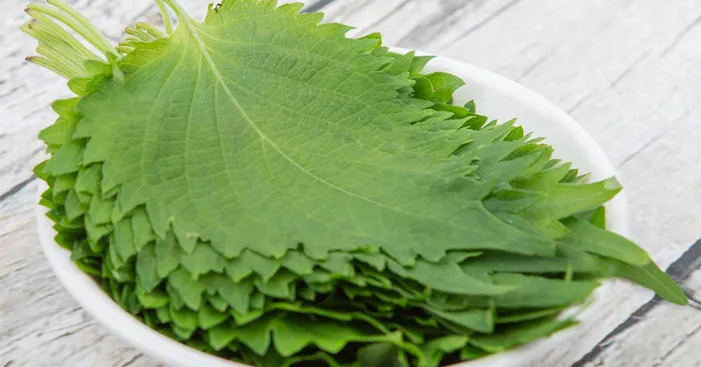
Nutritional values:
Shiso, a culinary herb hailing from East Asia, has long been celebrated for its vibrant flavor and array of health-promoting properties.
Its leaves, both fresh and dried, offer an abundance of vitamins and minerals, including a remarkable concentration of beta-carotene, calcium, and vitamin B1.
This nutritional powerhouse also harbors bioactive compounds like rosmarinic acid, shisoldehyde, and luteolin.
Shiso seeds, the byproduct of the shiso plant, are another nutritional gem, boasting α-linolenic acid, an essential fatty acid, along with rosmarinic acid and luteolin.
Health benefits:

Easing Seafood Allergy Symptoms:
Shiso and ginger decoction can provide relief from the unpleasant symptoms of seafood allergies, such as vomiting, diarrhea, and abdominal pain.
Shielding Against Cancer:
Shiso leaves have demonstrated significant effectiveness in reducing the incidence of cancer induced by chemical carcinogens.
They also have the potential to shrink tumors and delay their onset.
Combating Colds:
Shiso leaves, a versatile herb native to East Asia, have long been valued for their medicinal properties.
One of their most prominent benefits lies in their ability to combat the common cold, particularly the wind-chill variety.
This condition, often caused by exposure to cold and windy conditions, manifests in symptoms like headaches, nasal congestion, and a general feeling of coldness.
Shiso leaves, with their warming nature, effectively dispel wind and cold, alleviating these symptoms and promoting recovery.
Chronic Bronchitis:
Chronic bronchitis, a persistent inflammation of the airways, can also be effectively managed with shiso leaves.
Often triggered by bacterial or viral infections or exposure to irritants, chronic bronchitis leads to symptoms like coughing and phlegm buildup.
Shiso leaves, with their anti-inflammatory properties, can significantly reduce these symptoms and gradually resolve the underlying inflammation.
Enhancing Immunity:
Shiso leaves are a rich source of essential nutrients, including carotene, vitamin C, vitamin B2, and various minerals.
These nutrients play a crucial role in maintaining overall health, particularly in children.
They are essential for growth and development, and shiso leaves provide an abundance of these nutrients, effectively boosting immunity and promoting the healthy development of various organs.
Cognitive Development:
In adults, shiso leaves help combat oxidative stress, preventing premature aging and protecting vital organs.
Shiso leaf oil, extracted from the leaves, holds further remarkable benefits.
It has been shown to enhance cognitive function and strengthen the brain.
Pregnant women often consume shiso leaf oil to promote fetal brain development, and it can also be administered to infants in moderate amounts to support their rapid growth and overall health.
Preventing Thrombosis:
Shiso oil can hinder platelet aggregation and serotonin release, thereby preventing the formation of blood clots and offering antithrombotic effects.
Combating Colds and Flus:
Shiso leaves can effectively combat the symptoms of colds and flu, including chills, fever, shivering, dizziness, and nasal congestion.
Shiso possesses the ability to dispel heat from the body’s surface.
Precautions before consuming Shiso:

Individuals prone to frequent diarrhea or other digestive issues should exercise caution when consuming shiso, as its strong nature may aggravate their symptoms.
Shiso, a trusted culinary gem, can be enjoyed in various ways, whether soaked in water or incorporated into cooked dishes.
Its delightful flavor and potential health benefits make it a worthwhile addition to a balanced diet.
Qi Deficiency:
Shiso’s pungent and warming nature can induce sweating, which can exacerbate the condition of individuals with qi deficiency.
Consuming shiso in this case may lead to further depletion of their vital energy and blood, potentially worsening their physical discomfort.
Therefore, people with qi deficiency should avoid shiso consumption.
Allergies:
Certain individuals may experience allergic reactions, gastrointestinal discomfort, or skin irritation after exposure to or consumption of shiso.
In severe cases, these reactions can extend to the respiratory tract, causing breathing difficulties.
Therefore, individuals with shiso allergies should refrain from consuming it.
Using Shiso:
Shiso Snails:
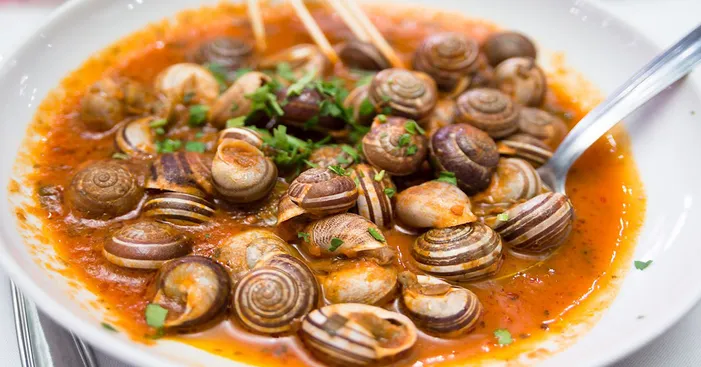
Ingredients:
- Fresh shiso leaves
- Snails
- Fresh ginger root
- Garlic cloves
- Green bell peppers
- Red bell peppers
- Various seasonings
Preparation:
- Clean the snails: Soak the snails in water for 1-2 days.
- This will allow them to expel any impurities from their bodies.
- Adding a few drops of vegetable oil to the water can speed up this process.
- Before cooking, cut off the tails of the snails.
- Scrub the snails: Once the snails have expelled the sediment, rub them thoroughly with your hands under running water to remove any remaining debris from their shells.
- Blanch the snails: Bring a pot of water to a boil.
- Add bay leaves, star anise, cinnamon sticks, and dried peppercorns.
- Pour in a small amount of Huadiao wine or cooking wine.
- Once the water is boiling, add the snails and blanch for a few minutes.
- Drain the snails and rinse them under running water.
- Prepare the vegetables: Wash and chop the shiso leaves.
- Mince the ginger and garlic cloves.
- Remove the stems from the green and red bell peppers, wash them, and slice them thinly.
- Stir-fry the snails: Heat oil in a wok or large pan.
- Add bay leaves, star anise, cinnamon sticks, and dried peppercorns.
- Fry until fragrant.
- Add the minced garlic, ginger slices, and green and red peppers. Stir-fry until fragrant. Add the blanched snails and stir-fry quickly.
- Season with a small amount of salt,
- Cook the snails: Pour in lukewarm water, salt, soy sauce, and other seasonings.
- Simmer for a while, until the snails are tender and the sauce has thickened.
- Add the chopped shiso leaves and stir-fry until they wilt.
- Continue to cook until the sauce is almost dry.
- Turn off the heat and serve immediately.
Shiso fish stew:

Ingredients:
- 1 carp carcass, cleaned and scaled
- A handful of shiso leaves, washed and drained
- 2 tablespoons of salad oil
- 2 green onions, thinly sliced
- 1 tablespoon of ginger, minced
- 2 cloves of garlic, minced
- 1 dried chili pepper, crushed
- 1 tablespoon of cooking wine
- 1 tablespoon of light soy sauce
- 1 teaspoon of dark soy sauce
- 1 tablespoon of bean paste
- 1 teaspoon of sugar
Preparation:
- Heat the oil in a large skillet over medium heat. Add the green onions, ginger, garlic, and chili pepper and cook until fragrant, about 30 seconds.
- Add the carp carcass to the skillet and cook until browned on both sides, about 5 minutes per side.
- Pour in the cooking wine and bring to a simmer. Add the light soy sauce, dark soy sauce, bean paste, and sugar.
- Cover the skillet and simmer for 10-15 minutes, or until the carp is cooked through.
- Stir in the shiso leaves and cook for 1-2 minutes, or until wilted.
- Taste and adjust seasonings as needed.
- Serve immediately with rice or noodles.
Traditional Chinese medicine:
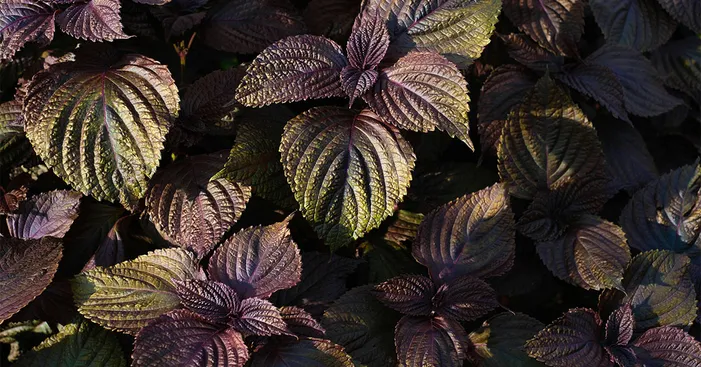
Shiso, a revered herbal remedy in traditional Chinese medicine, holds immense power against wind and cold, effectively combating ailments like wind chill and pulmonary syndrome.
Characterized by chills, fever, aversion to wind, nasal congestion, runny nose, coughing, asthma, thin white mucus, and body aches, wind chill syndrome is often treated with a decoction of ginger, green onion, shiso leaves, and coriander.
Shiso’s effectiveness stems from its ability to alleviate surface symptoms.
When external wind and cold qi induce fever, cold sensitivity, headaches, and coughs, shiso’s dispersing and heat-clearing properties effectively dispel the cold, making it an ideal remedy for common wind chill colds.
Even a simple cup of shiso tea can serve as a preventive measure against wind exposure and rain.
Due to the long summer season and the heavy summer humidity, it is easy to experience dizziness, brain swelling, and other discomforts.
However, drinking shiso tea can help to alleviate these symptoms and promote overall well-being.
Shiso tea’s cooling properties can help regulate body temperature and reduce excess moisture, effectively combating summer heat and promoting a healthy balance.
Choosing fresh Shiso:
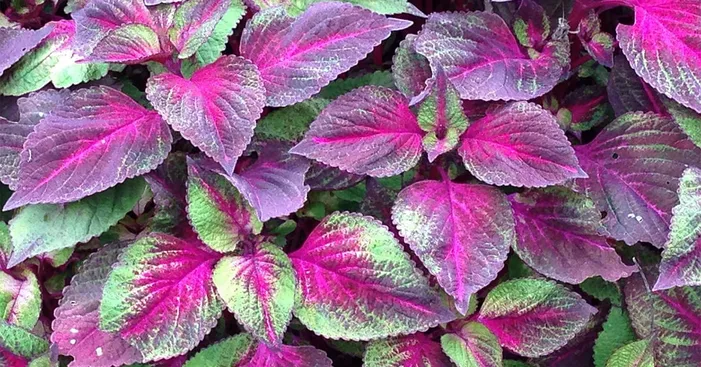
When selecting shiso, opt for bunches with vibrant colors and leaves that are crisp and firm from base to tip.
A pleasant aroma is another indicator of freshness.
Avoid shiso with any signs of discoloration at the stem end, as this suggests overripeness.
Overly large leaves often lack both flavor and aroma.
For red shiso, choose bunches with deeply colored undersides, as this implies freshness.
Additionally, since red shiso flower spikes tend to bloom rapidly, select bunches with an abundance of buds to prolong their freshness.
Storing shiso:
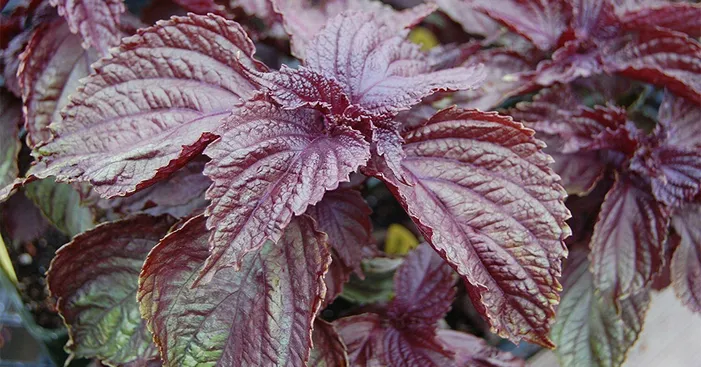
- Trim the stems using scissors, leaving only the leafy portion.
- Ensure the shiso leaves are completely dry; even a slight dampness can affect their preservation.
- Individually wrap each meal-sized portion of shiso in a clean paper towel and place them in a crisper drawer.
- Alternatively, wrap each meal-sized portion of shiso in a paper towel and place it in a plastic bag or airtight container.
Excess moisture can lead to spoilage.
Thoroughly dry the leaves using absorbent paper, not just a light wipe.
If the leaves retain some dampness, avoid storing them in the refrigerator.
Instead, place them in a well-ventilated area to dry quickly.
However, do not leave them overnight, as they may become overly dry and unusable.
If drying is not preferable, consume the leaves on the same day.
